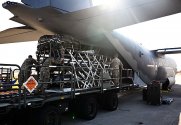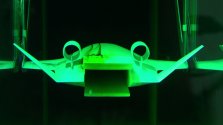You are using an out of date browser. It may not display this or other websites correctly.
You should upgrade or use an alternative browser.
You should upgrade or use an alternative browser.
H-20 bomber (with H-X, JH-XX)
- Thread starter Deino
- Start date
Same here. His points kinda be like an elastic ball bouncing non-stop around the room.This sounds crazy and chaotic. I don’t know what to extract out of it.
Also, I have never seen the PLA having actually decided on how many units of any particular equipment and platform that they are procuring based on per unit costs alone, even before the mass production starts. Never before.
Besides, even if the quoted price tag is accurate, 3.8 billion RMB for a 200-ton, 4-engined VLO bomber is equal to somewhere around 560 million USD today. Even without the economies of scale pressing the price tag down, 560 million is still expected to be considerably cheaper than the (supposedly) twin-engined B-21, let alone the B-2 which the H-20 is expected to be its counterpart.
Furthermore, the USAF has clearly stated their intentions of procuring 100-200 B-21s. If it wasn't because of the unjustifiable costs, the USAF could have procured at least 130 B-2s instead of just 21.
But according to this guy - "Yeah, sure, let's just procure 40 H-20s and call it a day." I mean, WTH? Hard to believe that the higher ups in the PLAAF would ever agree to that, when the H-6 already has 200+ airframes (and half of which would require immediate replacement within the next couple of years).
Last edited:
If that so called leak was real, he would've been "invited" for a cup of tea the next day. It's likely a BS. Technicals aside, China needs more B-52 style multi purpose bombers than a ultra high tech and ultra expensive cold-war style stealth bomber. Saber rattling and stand-offs in the taiwan strait require more day-to-day "trucks" like conventional bombers than B-2's.
There are three options:If that so called leak was real, he would've been "invited" for a cup of tea the next day. It's likely a BS. Technicals aside, China needs more B-52 style multi purpose bombers than a ultra high tech and ultra expensive cold-war style stealth bomber. Saber rattling and stand-offs in the taiwan strait require more day-to-day "trucks" like conventional bombers than B-2's.
Option 1 - JH-XX, if it is really a thing and not vaporware, can play the role of missile trucks. JH-XX's smaller size compared to the H-20 means they can be procured in larger numbers, which also increases their deployment versatility.
Option 2 - New bomber model, but based on the flying-wing design. This can be made possible since VLO is not a strict requirement compared to VLO bombers like the H-20 and B-21, hence their payload capacity can be much larger.
Option 3 - Using airlifters like the Y-8, Y-9 and Y-20 to function as bombers. The Rapid Dragon missile system from the US is a great example for reference.

Related to the 2nd point: Apart from being a bomber, here's this flying wing airlifter design from Boeing with the rear cargo bay door open. Similarly, a missile system like the Rapid Dragon can be deployed using flying wing airlifters as well.

Last edited:
All I see was a frog.There are three options:
Option 1 - JH-XX, if it is really a thing and not vaporware, can play the role of missile trucks. JH-XX's smaller size compared to the H-20 means they can be procured in larger numbers, which also increases their deployment versatility.
Option 2 - New bomber model, but based on the flying-wing design. This can be made possible since VLO is not a strict requirement compared to VLO bombers like the H-20 and B-21, hence their payload capacity can be much larger.
Option 3 - Using airlifters like the Y-8, Y-9 and Y-20 to function as bombers. The Rapid Dragon missile system from the US is a great example for reference.
View attachment 107068
Related to the 2nd point: Apart from being a bomber, here's this flying wing airlifter design from Boeing with the rear cargo bay door open. Similarly, a missile system like the Rapid Dragon can be deployed using flying wing airlifters as well.
View attachment 107069
not to derail, but airlifters is not a good option since PLAAF cannot assume air superiority in the relevant theaters where air striking is possible. The better 'cheap option' for volume would be to maximize munitions compatibility with fighters, like what Russia did with their Su-34 and Mig-31s with Kh-55 and Kinzhal respectively.There are three options:
Option 1 - JH-XX, if it is really a thing and not vaporware, can play the role of missile trucks. JH-XX's smaller size compared to the H-20 means they can be procured in larger numbers, which also increases their deployment versatility.
Option 2 - New bomber model, but based on the flying-wing design. This can be made possible since VLO is not a strict requirement compared to VLO bombers like the H-20 and B-21, hence their payload capacity can be much larger.
Option 3 - Using airlifters like the Y-8, Y-9 and Y-20 to function as bombers. The Rapid Dragon missile system from the US is a great example for reference.
Related to the 2nd point: Apart from being a bomber, here's this flying wing airlifter design from Boeing with the rear cargo bay door open. Similarly, a missile system like the Rapid Dragon can be deployed using flying wing airlifters as well.
If the Chinese Flankers like J-11s and J-16s can carry heavy long range strike missiles the way Su-34 and Mig-31 can, as opposed to only short ranged tactical ones, it would greatly decrease the burden on bombers. PLAAF needs a 1000 km, fighter carried ground strike missile. Anything with merely 200-300 km range is too short legged.
I think the opposite, an all H-20 force with a handful of older planes only as ALBM carriers is more likely.If that so called leak was real, he would've been "invited" for a cup of tea the next day. It's likely a BS. Technicals aside, China needs more B-52 style multi purpose bombers than a ultra high tech and ultra expensive cold-war style stealth bomber. Saber rattling and stand-offs in the taiwan strait require more day-to-day "trucks" like conventional bombers than B-2's.
China has good defenses over the Taiwan area already. But it also needs to develop a counterattack ability.
The current front has Chinese dominance in the first island chain, with SK being US' only outpost there which can be rapidly taken out if they don't declare neutrality. Japan, Guam and the rest of the second island chain remain contested territory, and further out is American dominated areas where only sporadic strikes are possible.
With an all H-20 force, China can execute succesful mass strategic bombing of Japan (as well as the Philippines if needed) and greatly extend the area of counterattack dominance.
Well, the idea is for the airlifters to drop standoff missiles, so that they can stay safe and outside of actively contested airspaces while letting allied fighters and/or UCAVs further ahead to provide guidances and designate targets for these missiles.not to derail, but airlifters is not a good option since PLAAF cannot assume air superiority in the relevant theaters where air striking is possible. The better 'cheap option' for volume would be to maximize munitions compatibility with fighters, like what Russia did with their Su-34 and Mig-31s with Kh-55 and Kinzhal respectively.
If the Chinese Flankers like J-11s and J-16s can carry heavy long range strike missiles the way Su-34 and Mig-31 can, as opposed to only short ranged tactical ones, it would greatly decrease the burden on bombers. PLAAF needs a 1000 km, fighter carried ground strike missile. Anything with merely 200-300 km range is too short legged.
In fact, the missiles that are intended for the American Rapid Dragon are JASSMs and LRASMs, both of which have ranges of 1000-2000 kilometers. The other main munition type for the Rapid Dragon is the JDAM, which is never going to be deployed unless their targets have zero SAM capabilities.
Fighters like the J-11s and J-20s, meanwhile, would better serve as escorts for the H-6, H-20 (and perhaps JH-XX) bombers and these airlifter-based "temporary bombers". Having the fighters carry long range strike missiles when sufficient long-range AShMs/LACMs are available could potentially impact their ability to ward off interceptions by enemy fighters and SAMs, and hence, their main duty as fighter escorts.
Last edited:
*... when sufficient long-range AShM/LACM launch platforms are available... (I forgot the necessary words)Having the fighters carry long range strike missiles when sufficient long-range AShMs/LACMs are available could potentially impact their ability to ward off interceptions by enemy fighters and SAMs, and hence, their main duty as fighter escorts.
Even 1000 km range is too short for a non optimized plane for the PLA IMO. A F-22 already in the air on patrol outside radar range at 1000 km can detect and close the gap with a high RCS cargo plane at afterburner Mach 2 within 20 min, and the cargo plane would have no way to escape or fight back the way a fighter could. It's very hard for the cargo plane to escape a few AIM-120s while a real bomber or fighter can maneuver away, be not detected in the first place, or deploy countermeasures.Well, the idea is for the airlifters to drop standoff missiles, so that they can stay safe and outside of actively contested airspaces while letting allied fighters and/or UCAVs further ahead to provide guidances and designate targets for these missiles.
In fact, the missiles that are intended for the American Rapid Dragon are JASSMs and LRASMs, both of which have ranges of 1000-2000 kilometers. The other main munition type for the Rapid Dragon is the JDAM, which is never going to be deployed unless their targets have zero SAM capabilities.
Fighters like the J-11s and J-20s, meanwhile, would better serve as escorts for the H-6, H-20 (and perhaps JH-XX) bombers and these airlifter-based "temporary bombers". Having the fighters carry long range strike missiles when sufficient long-range AShMs/LACMs are available could potentially impact their ability to ward off interceptions by enemy fighters and SAMs, and hence, their main duty as fighter escorts.
Unlike for the US which has a huge domestic civil aviation industry, cargo planes are very expensive in China, more than fighters, and more limited in numbers.
